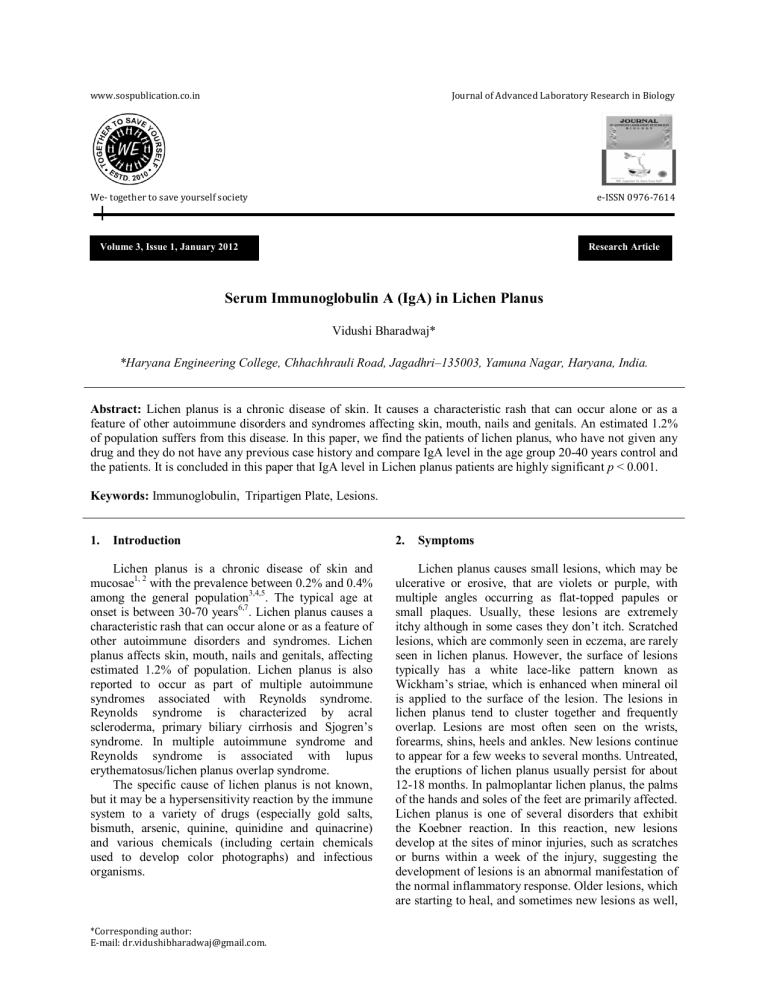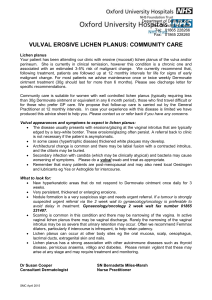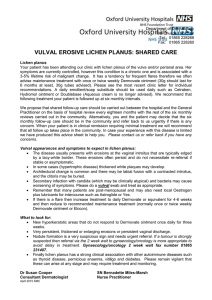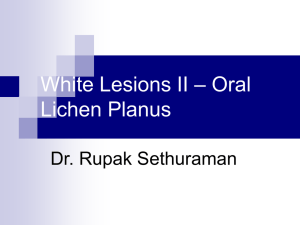
www.sospublication.co.in Journal of Advanced Laboratory Research in Biology We- together to save yourself society e-ISSN 0976-7614 Volume 3, Issue 1, January 2012 Research Article Serum Immunoglobulin A (IgA) in Lichen Planus Vidushi Bharadwaj* *Haryana Engineering College, Chhachhrauli Road, Jagadhri–135003, Yamuna Nagar, Haryana, India. Abstract: Lichen planus is a chronic disease of skin. It causes a characteristic rash that can occur alone or as a feature of other autoimmune disorders and syndromes affecting skin, mouth, nails and genitals. An estimated 1.2% of population suffers from this disease. In this paper, we find the patients of lichen planus, who have not given any drug and they do not have any previous case history and compare IgA level in the age group 20-40 years control and the patients. It is concluded in this paper that IgA level in Lichen planus patients are highly significant p < 0.001. Keywords: Immunoglobulin, Tripartigen Plate, Lesions. 1. Introduction Lichen planus is a chronic disease of skin and mucosae1, 2 with the prevalence between 0.2% and 0.4% among the general population3,4,5. The typical age at onset is between 30-70 years6,7. Lichen planus causes a characteristic rash that can occur alone or as a feature of other autoimmune disorders and syndromes. Lichen planus affects skin, mouth, nails and genitals, affecting estimated 1.2% of population. Lichen planus is also reported to occur as part of multiple autoimmune syndromes associated with Reynolds syndrome. Reynolds syndrome is characterized by acral scleroderma, primary biliary cirrhosis and Sjogren’s syndrome. In multiple autoimmune syndrome and Reynolds syndrome is associated with lupus erythematosus/lichen planus overlap syndrome. The specific cause of lichen planus is not known, but it may be a hypersensitivity reaction by the immune system to a variety of drugs (especially gold salts, bismuth, arsenic, quinine, quinidine and quinacrine) and various chemicals (including certain chemicals used to develop color photographs) and infectious organisms. *Corresponding author: E-mail: dr.vidushibharadwaj@gmail.com. 2. Symptoms Lichen planus causes small lesions, which may be ulcerative or erosive, that are violets or purple, with multiple angles occurring as flat-topped papules or small plaques. Usually, these lesions are extremely itchy although in some cases they don’t itch. Scratched lesions, which are commonly seen in eczema, are rarely seen in lichen planus. However, the surface of lesions typically has a white lace-like pattern known as Wickham’s striae, which is enhanced when mineral oil is applied to the surface of the lesion. The lesions in lichen planus tend to cluster together and frequently overlap. Lesions are most often seen on the wrists, forearms, shins, heels and ankles. New lesions continue to appear for a few weeks to several months. Untreated, the eruptions of lichen planus usually persist for about 12-18 months. In palmoplantar lichen planus, the palms of the hands and soles of the feet are primarily affected. Lichen planus is one of several disorders that exhibit the Koebner reaction. In this reaction, new lesions develop at the sites of minor injuries, such as scratches or burns within a week of the injury, suggesting the development of lesions is an abnormal manifestation of the normal inflammatory response. Older lesions, which are starting to heal, and sometimes new lesions as well, Serum Immunoglobulin A (IgA) in Lichen Planus Vidushi Bharadwaj may occasionally develop a muddy-brown pigmentation, which may be intense in skin creases. In about 75 percent of cases, patients with lichen planus develop oral lesions with a white lace-like pattern. 3. 5. Fifty patients suffering from psoriasis and fifty healthy controls comprised the clinical material for the present study. Cases were selected from those attending the outpatient department or the ward of Department of Dermatology, SVBP Hospital attached to LLRM Medical College, Meerut. The estimation of serum immunoglobulin IgG was carried out in Biochemistry department of LLRM Medical College, Meerut. All the patients were divided into three age group 20-40 years, 40-60 years and 60 years and above. 30 cases were male and 20 cases were female. The Controls were divided into three age groups as in the patients group. 25 controls were male and 25 were female. All the controls were examined clinically to make sure that none of them had any previous or present dermatological problem. Diagnosis Lichen planus must be differentiated from eczema, psoriasis, the discoid rash of lupus, and granuloma annulare. When lesions occur in unusual locations on the body, diagnosis may be difficult. The lesions in lichen planus, however, are typically small and have a narrow border compared to granuloma annulare or the lesions that accompany infections. The presence of other autoimmune disorders in patients with characteristic purple skin lesions suggests a diagnosis of lichen planus. 4. Materials and Methods Cause 6. As above mentioned that the cause of lichen planus is not known. It is not contagious[6] and does not involve any known pathogen. Some lichen planus-type rashes (known as lichenoid reactions) occur as allergic reactions to medications for high blood pressure, heart disease and arthritis, in such cases termed drug-induced lichenoid reactions. These lichenoid reactions are referred to as lichenoid mucositis (of the mucosa) or dermatitis (of the skin). Lichen planus has been reported as a complication of chronic hepatitis C virus infection and can be a sign of chronic graft-versus-host disease of the skin (Lichenoid reaction of graft-versushost disease). It has been suggested that true lichen planus may respond to stress, where lesions may present on the mucosa or skin during times of stress in those with the disease. Lichen planus affects women more than men (at a ratio of 3:2) and occurs most often in middle-aged adults. The involvement of the mucous membranes is seen frequently and usually, is asymptomatic, but occasionally, Lichen planus can be complicated by extensive painful erosions[7]. It is observed rarely in children. In unpublished clinical observation, lichen planus appears to be associated with hypothyroidism. Allergic reactions to amalgam fillings may contribute to the oral lesions very similar to lichen planus, and a systematic review found that many of the lesions resolved after the fillings were replaced[8]. Estimation of Serum Immunoglobulin The serum immunoglobulin G (IgG) was measured by “Single Radial Immunodiffusion (SRID)” Direct method of Mancini and coworkers (1965). Estimation of lgG was carried out by using tripartigen plate (immune diffusion plates for quantitative determination), by diagnostic kit from Boehringer company (Germany) supplied by Hoechst pharmaceutical, Bombay, in control group and in patient of psoriasis. 7. Result and Discussion Immunoglobulin A (IgA) was estimated in blood of normal healthy volunteers and patients with lichen planus. As evident from Table - 1, in all patients of lichen planus, the serum IgA level ranged between 0.511.88gm/1 (means ± SD, 1.11 ± 0.36). This, when compared to control, was significantly high (p < 0.001). In the age group 20-40 years, 40-60 years, 60 years and above, all patients the serum IgG level ranged between 20.00-39.99gm/l (mean ± SD, 27.32 ± 5.74), 20.09-37.43gm/l (mean ± SD, 27.20 ± 5.64) and 20.01-37.81gm/1 (Mean ± SD, 27.29 ± 5.64) as compared to healthy subjects. It is significantly high (p < 0.001). Table 1. Serum lgA level in cases of Control according to age and sex. J. Adv. Lab. Res. Biol. S. No. Age group (Years) 1 2 3 20-40 40-60 60 & above Total n 20 20 10 50 Control Range 0.93 - 2.80 0.92 - 2.78 0.92 - 2.75 0.92 - 2.8 Mean SD 1.86 ± 0.65 1.90 ± 0.65 1.8 ± 0.68 1.87 ± 0.64 40 Serum Immunoglobulin A (IgA) in Lichen Planus Vidushi Bharadwaj Table 2. Serum lgA level in cases of Lichen planus according to age and sex. S. No. Age group (Years) 1 2 3 20-40 40-60 60 & above Total n 25 15 10 50 Patients of Lichen planus Range Mean SD 0.51 - 1.88 1.17 ± 0.54 0.66 - 1.72 1.16 ± 0.35 0.65 - 1.11 0.88 ± 0.17 0.51 - 1.88 1.11 ± o.36 P-value <0.001 <0.001 <0.001 <0.001 Value expressed in gm/l; N=number of cases; ‘p’ value significance References [1]. Boyd, A.S. & Neldner, K.H. (1991). Lichen planus. J. Am. Acad. Dermatol., 25(4): 593-619. doi: 10.1016/0190-9622(91)70241-s. [2]. Ramón-Fluixá, C., Bagán-Sebastián, J., MiliánMasanet, M. & Scully, C. (1999). Periodontal status in patients with oral lichen planus: a study of 90 cases. Oral Dis., 5(4): 303-306. [3]. Salem, G. (1989). Oral lichen planus among 4277 patients from Gizan, Saudi Arabia. Community Dent Oral Epidemiol., 17(6): 322–324. doi: 10.1111/j.1600-0528.1989.tb00647.x. [4]. Borghelli, R.F., Policicchio, J.E., Stirparo, M.A., Ceccotti, E. & Chuchurru, J.A. (1990). Oral lichen planus: epidemiological observations in Argentina. Rev. Asoc. Odontol. Argent., 78(1): 2326. J. Adv. Lab. Res. Biol. [5]. Ikeda, N., Handa, Y., Khim, S.P., Durward, C., Axéll, T., Mizuno, T., Fukano, H. & Kawai T. (1995). Prevalence study of oral mucosal lesions in a selected Cambodian population. Community Dent. Oral Epidemiol., 23(1): 49-54. doi: 10.1111/j.1600-0528.1995.tb00197.x. [6]. Penn State College of Medicine - Lichen Planus (http://www.hmc.psu.edu/healthinfo/jkl/lichenpla nus.htm). [7]. Yu, T.C., Kelly, S.C., Weinberg, J.M., & Scheinfeld, N.S. (2003). Isolated lichen planus of the lower lip. Cutis, 71(3): 210-2. [8]. Issa, Y., Brunton, P.A., Glenny, A.M. & Duxbury, A.J. (2004). Healing of oral lichenoid lesions after replacing amalgam restorations: a systematic review. Oral Surg. Oral Med. Oral Pathol. Oral Radiol. Endod., 98(5): 553–565. doi: 10.1016/j.tripleo.2003.12.027. 41




